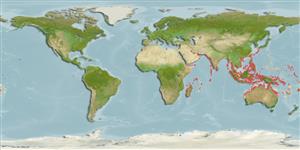Classificação / Names
Nomes comuns | Sinónimos | Catalog of Fishes(Género, Espécies) | ITIS | CoL | WoRMS | Cloffa
>
Clupeiformes (Herrings) >
Engraulidae (Anchovies) > Engraulinae
Etymology: Encrasicholina: Greek, egkrasicholos, -os, -on = mixed with spleen.
More on author: Whitley.
Issue
formerly ENGR Stol 7
Environment: milieu / climate zone / depth range / distribution range
Ecologia
marinhas; estuarina associadas(os) a recifes. Tropical; 32°N - 28°S, 43°E - 173°W (Ref. 189)
Indo-Pacific: widespread in the northern part of the Indian Ocean (Gulf of Aden, but apparently not the Red Sea nor Kenya, the Persian Gulf, India, Andaman Islands) and Western Central Pacific (Indonesia, Thailand, north to at least Taiwan Island, south to northern Australia; also eastward to Fiji and Tonga).
Length at first maturity / Tamanho / Peso / Idade
Maturity: Lm 6.1, range 4 - ? cm
Max length : 9.7 cm TL macho/indeterminado; (Ref. 55634); 10.0 cm TL (female); peso máx. Publicado: 8.00 g (Ref. 55634); peso máx. Publicado: 8.00 g
Espinhos anais: 0; Raios anais moles: 18 - 20. Diagnosis: Body rather cylindrical, belly rounded, with 5-6, rarely 3 or 4, sharp needle-like pre-pelvic scutes; maxilla tip pointed, projecting beyond second supra-maxilla and reaching to sub-operculum; isthmus short, preceded by a small bony plate on urohyal between branchial membranes; lower gillrakers 20-27; unbranched dorsal and anal finrays 3, anal fin short, with usually 15-17 branched finrays; in life, a bright silver band on flank, with a thin blue line above, back blue/grey (Ref. 189). It closely resembles Encrasicholina heteroloba, which has only 2 unbranched dorsal and anal finrays, a dull silver/grey band on flank, and the back beige; Encrasicholina oligobranchus has only 17-18 gillrakers; other species of Encrasicholina have a fleshy urohyal plate and a maxilla tip blunt and not projecting beyond the second supra-maxilla; species of Stolephorus have a long isthmus reaching to the margin of the branchial membrane (Ref. 189).
Whitehead, P.J.P., G.J. Nelson and T. Wongratana, 1988. FAO Species Catalogue. Vol. 7. Clupeoid fishes of the world (Suborder Clupeoidei). An annotated and illustrated catalogue of the herrings, sardines, pilchards, sprats, shads, anchovies and wolf-herrings. FAO Fish. Synop. 125(7/2):305-579. Rome: FAO. (Ref. 189)
Categoria na Lista Vermelha da IUCN (Ref. 130435)
Ameaça para o homem
Harmless
Utilização humana
Pescarias: pouco comercial; isco: usually
Ferramentas
Relatórios especiais
Descarregue XML
Fontes da internet
Estimates based on models
Preferred temperature (Ref.
123201): 25.1 - 29.3, mean 28.5 °C (based on 3195 cells).
Phylogenetic diversity index (Ref.
82804): PD
50 = 0.5039 [Uniqueness, from 0.5 = low to 2.0 = high].
Bayesian length-weight: a=0.00550 (0.00464 - 0.00651), b=3.12 (3.08 - 3.16), in cm total length, based on LWR estimates for this species (Ref.
93245).
Nível Trófico (Ref.
69278): 3.3 ±0.1 se; based on diet studies.
Resiliência (Ref.
120179): Elevada, tempo mínimo de duplicação da população menor que 15 meses (K=2.00-5.04; tm=0.29; tmax=1.7).
Prior r = 1.19, 95% CL = 0.79 - 1.79, Based on 1 data-limited stock assessment.
Fishing Vulnerability (Ref.
59153): Low vulnerability (10 of 100).
Nutrients (Ref.
124155): Calcium = 239 [65, 779] mg/100g; Iron = 1.47 [0.53, 3.85] mg/100g; Protein = 19.7 [17.2, 21.8] %; Omega3 = 0.207 [0.089, 0.481] g/100g; Selenium = 39.9 [12.9, 127.6] μg/100g; VitaminA = 37.5 [9.1, 191.7] μg/100g; Zinc = 2.21 [1.24, 5.33] mg/100g (wet weight); based on
nutrient studies.
